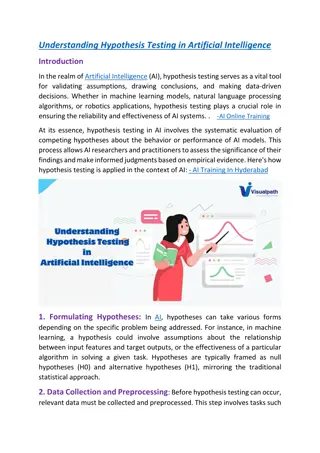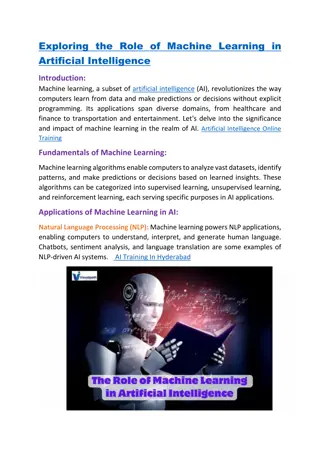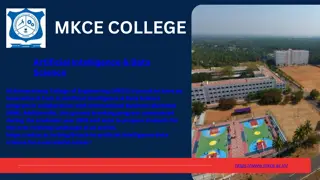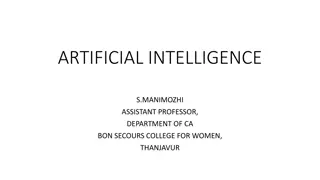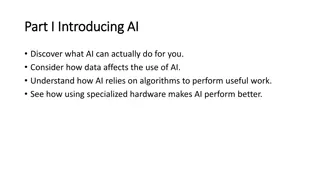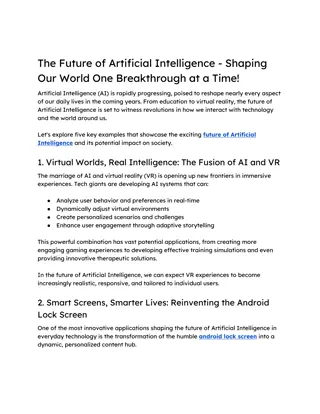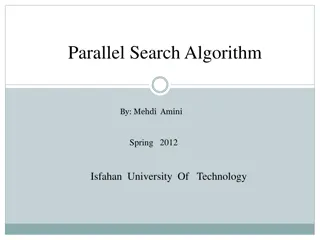Understanding Informed and Uninformed Search Algorithms in Artificial Intelligence
Delve into the world of search algorithms in Artificial Intelligence with a focus on informed methods like Greedy Search and A* Search, alongside uninformed approaches such as Uniform Cost Search. Explore concepts like search problems, search trees, heuristic functions, and fringe strategies to comprehend how these algorithms work to find optimal solutions. Gain insights from examples like the Pancake Problem and General Tree Search to deepen your understanding of the principles underlying different search techniques.
Download Presentation

Please find below an Image/Link to download the presentation.
The content on the website is provided AS IS for your information and personal use only. It may not be sold, licensed, or shared on other websites without obtaining consent from the author. Download presentation by click this link. If you encounter any issues during the download, it is possible that the publisher has removed the file from their server.
E N D
Presentation Transcript
CS 188: Artificial Intelligence Informed Search Instructors: Dan Klein and Pieter Abbeel University of California, Berkeley [These slides were created by Dan Klein and Pieter Abbeel for CS188 Intro to AI at UC Berkeley. All CS188 materials are available at http://ai.berkeley.edu.]
Today Informed Search Heuristics Greedy Search A* Search Graph Search
Recap: Search Search problem: States (configurations of the world) Actions and costs Successor function (world dynamics) Start state and goal test Search tree: Nodes: represent plans for reaching states Plans have costs (sum of action costs) Search algorithm: Systematically builds a search tree Chooses an ordering of the fringe (unexplored nodes) Optimal: finds least-cost plans
Example: Pancake Problem Cost: Number of pancakes flipped
Example: Pancake Problem State space graph with costs as weights 4 2 3 2 3 4 3 4 2 3 2 2 4 3
General Tree Search Action: flip top two Cost: 2 Action: flip all four Cost: 4 Flip four, flip three Total cost: 7 Path to reach goal:
The One Queue All these search algorithms are the same except for fringe strategies Conceptually, all fringes are priority queues (i.e. collections of nodes with attached priorities) Practically, for DFS and BFS, you can avoid the log(n) overhead from an actual priority queue, by using stacks and queues Can even code one implementation that takes a variable queuing object
Uniform Cost Search Strategy: expand lowest path cost c 1 c 2 c 3 The good: UCS is complete and optimal! The bad: Explores options in every direction No information about goal location Start Goal [Demo: contours UCS empty (L3D1)] [Demo: contours UCS pacman small maze (L3D3)]
Search Heuristics A heuristic is: A function that estimates how close a state is to a goal Designed for a particular search problem Examples: Manhattan distance, Euclidean distance for pathing 10 5 11.2
Example: Heuristic Function Heuristic: the number of the largest pancake that is still out of place 3 h(x) 4 3 4 3 0 4 4 3 4 4 2 3
Greedy Search Expand the node that seems closest What can go wrong?
Greedy Search b Strategy: expand a node that you think is closest to a goal state Heuristic: estimate of distance to nearest goal for each state A common case: Best-first takes you straight to the (wrong) goal b Worst-case: like a badly-guided DFS [Demo: contours greedy empty (L3D1)] [Demo: contours greedy pacman small maze (L3D4)]
A* Search UCS Greedy A*
Combining UCS and Greedy Uniform-cost orders by path cost, or backward cost g(n) Greedy orders by goal proximity, or forward cost h(n) g = 0 h=6 8 S g = 1 h=5 h=1 e a 1 1 3 2 g = 9 h=1 g = 2 h=6 g = 4 h=2 S a d G b d e h=6 h=5 1 h=2 h=0 1 g = 3 h=7 g = 6 h=0 g = 10 h=2 c b c G d h=7 h=6 g = 12 h=0 G A* Search orders by the sum: f(n) = g(n) + h(n) Example: Teg Grenager
When should A* terminate? Should we stop when we enqueue a goal? h = 2 A 2 2 S G h = 3 h = 0 2 3 B h = 1 No: only stop when we dequeue a goal
Is A* Optimal? h = 6 1 3 A S h = 7 G h = 0 5 What went wrong? Actual bad goal cost < estimated good goal cost We need estimates to be less than actual costs!
Idea: Admissibility Inadmissible (pessimistic) heuristics break optimality by trapping good plans on the fringe Admissible (optimistic) heuristics slow down bad plans but never outweigh true costs
Admissible Heuristics A heuristic h is admissible (optimistic) if: where is the true cost to a nearest goal Examples: 4 15 Coming up with admissible heuristics is most of what s involved in using A* in practice.
Optimality of A* Tree Search Assume: A is an optimal goal node B is a suboptimal goal node h is admissible Claim: A will exit the fringe before B
Optimality of A* Tree Search: Blocking Proof: Imagine B is on the fringe Some ancestor n of A is on the fringe, too (maybe A!) Claim: n will be expanded before B 1. f(n) is less or equal to f(A) Definition of f-cost Admissibility of h h = 0 at a goal
Optimality of A* Tree Search: Blocking Proof: Imagine B is on the fringe Some ancestor n of A is on the fringe, too (maybe A!) Claim: n will be expanded before B 1. f(n) is less or equal to f(A) 2. f(A) is less than f(B) B is suboptimal h = 0 at a goal
Optimality of A* Tree Search: Blocking Proof: Imagine B is on the fringe Some ancestor n of A is on the fringe, too (maybe A!) Claim: n will be expanded before B 1. f(n) is less or equal to f(A) 2. f(A) is less than f(B) 3. n expands before B All ancestors of A expand before B A expands before B A* search is optimal
Properties of A* Uniform-Cost A* b b
UCS vs A* Contours Uniform-cost expands equally in all directions Start Goal A* expands mainly toward the goal, but does hedge its bets to ensure optimality Goal Start [Demo: contours UCS / greedy / A* empty (L3D1)] [Demo: contours A* pacman small maze (L3D5)]
Comparison Greedy Uniform Cost A*
A* Applications Video games Pathing / routing problems Resource planning problems Robot motion planning Language analysis Machine translation Speech recognition [Demo: UCS / A* pacman tiny maze (L3D6,L3D7)] [Demo: guess algorithm Empty Shallow/Deep (L3D8)]
Creating Admissible Heuristics Most of the work in solving hard search problems optimally is in coming up with admissible heuristics Often, admissible heuristics are solutions to relaxed problems, where new actions are available 366 15 Inadmissible heuristics are often useful too




